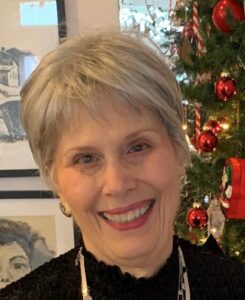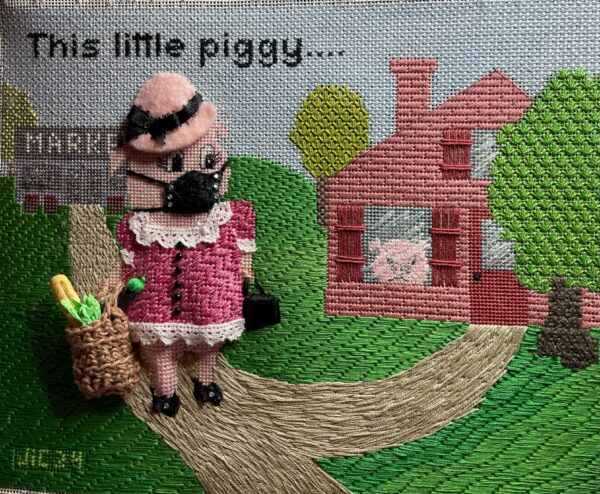The child of an army officer and later an Air Force officer’s wife, Loni Smith has moved 49 times in her life. She is used to change, making new friends, finding new doctors. But one unexpected change led to a life-long quest for better vision–keratoconus, a progressive thinning of the cornea that can cause the cornea to bulge into a conical shape, refracting light incorrectly and causing higher order aberrations, such as double vision.
doctors. But one unexpected change led to a life-long quest for better vision–keratoconus, a progressive thinning of the cornea that can cause the cornea to bulge into a conical shape, refracting light incorrectly and causing higher order aberrations, such as double vision.
Loni has spent her life making things, starting at age 5. She had always done something with her hands, such as knitting and sewing, and she has a bachelor’s degree in textiles and clothing. Her first craft book was published in 1970, and she wrote 11 more books in the following years. In between moves, Loni started teaching part-time adult education classes. But with keratoconus, she spent almost 30 years of her life where she could not see well enough to stitch.
“I made a life without stitching. I went to law school. As a professor, I taught business law and business management for 30 years. I took up a variety of arts and crafts, but my life without needlepoint was not fulfilling. Needlepoint had fed my soul.”
Seeing Double
At age 28, while living in Kansas City, she began to see double when reading. Curious, she went to the eye doctor who held up a sign. “How many dots do you see?” he asked. Loni counted and counted and counted. Her slow pace aggravated the doctor who asked, “How MANY dots do you see??” “I’m still counting,” Loni replied. There was only one dot on the sign. Loni was shocked. She had been driving fine, but the double vision she was encountering occurred only when she looked at things close up, such as letters and numbers. She didn’t have a diagnosis however, so she was referred to Johns Hopkins’ Wilmer Eye Institute in Maryland. There she was diagnosed with keratoconus, which was considered rare then, and was prescribed corneal rigid gas permeable lenses (RGPs), which were the only contact lenses available at the time.
She and her husband headed to Alaska for their next assignment. Her RGP hard contact lenses kept giving her corneal abrasions, and the doctor in Alaska struggled to fit her with better lenses. The Air Force flew her to Fort Lewis, an army post near Tacoma, Washington, where, coincidentally, her father’s best friend was Chief of Medicine. The ophthalmologist on staff fit a new RGP lens on both of Loni’s eyes, then placed the order with a lens manufacturer in Seattle, some 40 miles away. The Chief found Loni a place to stay and lent her his car. She drove to the manufacturer, picked up the lenses, returned to Tacoma, wore the lenses for the day, and the next morning the ophthalmologist tweaked the prescription. She did this every day for a month while friends pitched in to help her husband care for their 14-month-old son back in Alaska. At the end of the month, she could finally see well. Fitting a contact lens over a keratoconus-infected cornea at the time was more art than science.
“Then, I wrote The Needlepoint Book, which came out in 1976,” Loni says. “It made a huge splash because there was nothing like it.”
Corneal Transplants
For the next few years, Loni continued to create. She appeared on local talk shows to speak about The Needlepoint Book and needlepoint shops hired her to teach. When she was in larger cities, her publisher set up television and bookstore appearances. She was living a career beyond her dreams.
But keratoconus is progressive, and eventually, she needed corneal transplants, twice in each eye. “The first time I was told I needed a transplant there were only three doctors in the world doing them successfully – they were renowned for corneal transplants: one at Johns Hopkins, one at the University of Florida, and one at Mass Eye and Ear.”
Although her cornea transplant surgeries were not very painful, each time it was a full year before she could use RGP lenses again, as they touch the cornea. She also had dozens of cornea rejections. Doctors prescribed steroids every half hour when a rejection would start. Excess steroids cause cataracts, so when she was just 40 years old, she also had cataract surgery, normally a procedure for the elderly. Her first corneal transplant was in 1979 and her last was in 2005. Intermittently, for 15 years, she lived with vision in just one of her eyes, as doctors toggled between transplants.
Finding PROSE
Despite the transplants, her visual acuity continued to drop. At night she could only see a halo of lights. Her RGPs provided some visual improvement to 20/40 and 20/60, but the lens in Loni’s best eye continued to pop out and did so one night while she was driving. She had to pull over and call her husband to get her home. Then, in 2009, Johns Hopkins told her “Something out of Boston may be able to help you.”

A whimsical needlepoint project Loni completed in 2024. This little piggy going to market during Covid.
Loni visited Boston Foundation for Sight [now BostonSight] for a month, getting one to two lenses made every day. It took many fittings, but the doctors did not give up. The PROSE device restored her vision to 20/15, which she needed to stitch.
Finding Fulfillment
“My needlepoint career continued successfully. Shops and tradeshows hired me to teach again. At one tradeshow, I met a woman who said, ‘I’m your publisher.’ She wanted me to revise The Needlepoint Book again, so it has had multiple editions. The book is 48 years old and I’m still having book signings! Just two weeks ago I had a book signing near Daytona Beach.”
“If not for the PROSE device I would be functionally blind. That is not an exaggeration. Everything I do to enrich my life is visual. I wouldn’t have had the life that fed my soul if it hadn’t been for the PROSE device.”
The Needlepoint Book can be found online here.
(Jo Ippolito Christensen is Loni Smith’s pen name.)